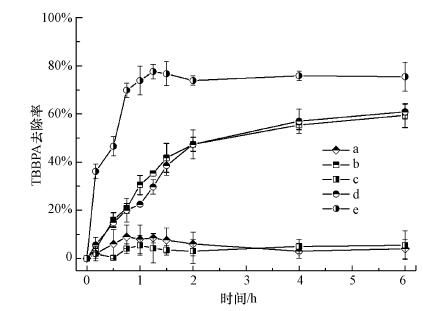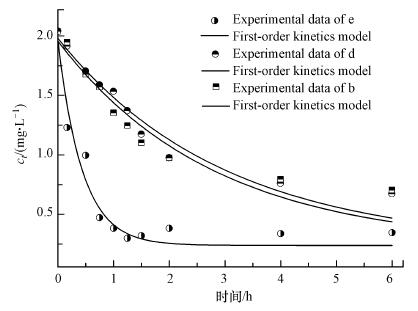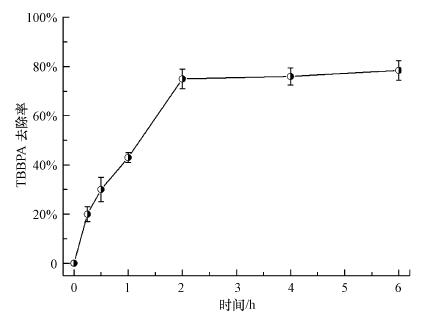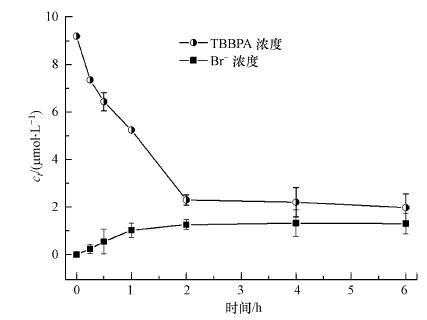 , 彭星星1,2, 贾晓珊1,2
, 彭星星1,2, 贾晓珊1,2

1. 中山大学环境科学与工程学院, 广州 510275;
2. 广东省环境污染控制与修复技术重点实验室, 广州 510275
收稿日期: 2017-12-13; 修回日期: 2017-01-25; 录用日期: 2017-01-25
基金项目: 广东省科技厅项目(No.2016A050503029);国家自然科学基金(No.41703086)
作者简介: 王张娜(1994-), 女, E-mail:15521261057@163.com
通讯作者(责任作者): 贾晓珊, E-mail:eesjxs@mail.sysu.edu.cn
摘要: 作为开发强化去除典型溴代阻燃剂四溴双酚A的重要一环,研究了厌氧微生物与Fe-Ni双金属材料联合对四溴双酚A的去除.结果显示:首先,联合体系较单独的厌氧微生物及单独的Fe-Ni双金属材料去除四溴双酚A有更高的去除率,6 h去除率可达到75.50%;联合体系四溴双酚A去除过程符合一级动力学模型,速率常数k为2.2917 h-1,半衰期为0.31 h.其次,利用基于BOX-Behnken(BBD)设计的响应面分析法(RSM)来寻找联合体系四溴双酚A的最佳去除条件,在初始接菌量为0.8,温度为29℃,TBBPA初始浓度为5 mg·L-1时,四溴双酚A的去除率最大.最后,受环境干扰情况的实验结果表明,自然水体条件或添加腐殖酸干扰情况下,均会造成联合体系对四溴双酚A去除率一定程度的降低.
关键词:四溴双酚A厌氧微生物Fe-Ni双金属响应面
Removal of Tetrabromobisphenol A (TBBPA) by synergistic integration of anaerobic microbes and Fe-Ni bimetallic particles
WANG Zhangna1,2
 , PENG Xingxing1,2, JIA Xiaoshan1,2
, PENG Xingxing1,2, JIA Xiaoshan1,2

1. School of Environmental Science and Engineering, Sun Yat-sen University, Guangzhou 510275;
2. Guangdong Provincial Key Laboratory of Environmental Pollution Control and Remediation Technology, Guangzhou 510275
Received 13 December 2017; received in revised from 25 January 2017; accepted 25 January 2017
Supported by the Guangdong Province Scientific and Technological Project (No.2016A050503029) and the National Natural Science Foundation of China (No.41703086)
Biography: WANG Zhangna (1994—), female, E-mail:15521261057@163.com
*Corresponding author: JIA Xiaoshan, E-mail:eesjxs@mail.sysu.edu.cn
Abstract: In view of the contamination of Tetrabromobisphenol A in environment, a novel integration of enriched TBBPA-degrading anaerobic microbles and Fe-Ni bimetallic particles was applied to remove TBBPA. A higher removal rate of Tetrabromobisphenol A was investigated in integration system compared to those using single anaerobic microorganism and Fe-Ni bimetallic simply. The degradation date fitted first-order kinetic model well with, the rate constant k of 2.2917 h-1, half-life of 0.31 h. A response surface methodology based on the BOX-Behnken design was applied to determine the optimum conditions. Under the optimal condition (an inoculum of 108 cell, a temperature of 29℃, and an initial concentration of TBBPA of 5 mg·L-1), the removal rate of Tetrabromobisphenol A reached 75.50% within 6 h. It's worth to point that TBBPA also can be reduced using synergistic integration of anaerobic microbes and Fe-Ni bimetallic particles even in natural water or the system containing of humic acid.
Key words: Tetrabromobisphenol Aanaerobic microblesFe-NiRSM
1 引言(Introduction)四溴双酚A(Tetrabromobisphenol A, TBBPA)是溴代阻燃剂的典型代表, 由于其优良的阻燃性能和低廉的价格被广泛应用于工业生产和日用品中, 包括电子产品、纺织、家具、防火材料、装饰物、塑料制品等(de WIT, 2002).近年来, 包括TBBPA在内的溴代阻燃剂对环境和人类健康造成的影响和危害正越来越引起人们的广泛关注.TBBPA在全球各种环境介质、生物体及人体内被广泛检出(Li et al., 2011;Wurl and Obbard, 2005;Mckinney et al., 2006;Luo et al., 2009;罗孝俊等, 2008).相关毒理研究表明, TBBPA对动植物细胞深具毒性, 特别对动物显示出包括甲状腺激素干扰、神经毒性、肝脏和肾脏毒性、免疫毒性、雌雄性干扰等广泛的致毒效应(杜青平等, 2012;Decherf et al., 2010;De Wit et al., 2008;Tada et al., 2006).在溴代阻燃剂已经被列入斯德哥尔摩公约中优先监控名单的今日, 尽管有关TBBPA的环境积累量、迁移转化规律及其生物富集毒性的研究已广泛开展, 但有关其去除的研究却明显滞后(邱孟德等, 2010;He et al., 2006).
元素铁是一种活泼金属, 具有还原性, 在自然环境中储量大, 开采利用成本低.近年来, 零价铁已经被广泛地用来降解和去除环境中的有机及无机污染物质, 是一种新兴的高效经济修复技术(Kanel et al., 2005;郑西来等, 2016).与其他物化方法相比, 零价铁处理法无需耗能且反应迅速, 但铁表面易被腐蚀钝化, 且易结块, 稳定性、耐用性的不足限制了其实际应用(Peng et al., 2017).Fe-Ni双金属颗粒通过增加反应表面活性位点提高零价铁的反应活性, 减少产物对材料的腐蚀以延长铁的使用寿命, 及加速还原反应的进行等方式改善了Fe处理技术(Parshetti and Doong, 2009;Fang et al., 2011), 并在TBBPA的去除应用方面取得了重要进展(Luo et al., 2012a;Peng et al., 2017).
微生物在持久性有机污染物的迁移转化乃至最终从环境中消失的过程中占有重要的地位.微生物法作为一种具有广泛适用性的修复技术, 发展相对成熟, 具有经济、高效且降解彻底的优势.在TBBPA的微生物去除方面尽管报道了许多研究成果(Gerecke et al., 2006;Peng et al., 2014), 但不管是混合还是纯培养系统, 都存在降解缓慢、周期长等不足(郑政伟等, 2010).鉴于此, 作为开发强化去除典型溴代阻燃剂TBBPA的重要一环, 本研究拟将微生物处理法与铁还原法两种修复技术结合, 采用厌氧微生物与Fe-Ni双金属联合体系来强化去除水体中的TBBPA.同时, 对联合体系的去除效果及其影响条件进行探讨, 为TBBPA的去除提供新的思路.
2 材料与方法(Materials and methods)实验采用的微生物来自本实验室驯化降解TBBPA菌群的反应器, 该反应器于2017年1月从广州市番禺区前锋污水处理厂取得活性污泥启动, 并长期提供含TBBPA的进水对反应器内的微生物菌群进行驯化.对出水中TBBPA的检测及微生物菌群去除TBBPA的活性显示, 经过半年的驯化后该反应器内的微生物菌群具有相当稳定的TBBPA降解活性.
2.1 主要试剂本实验过程使用的试剂TBBPA(分析纯, 98%)由北京百灵威试剂有限公司生产;还原铁粉及NiCl2试剂购于天津市永大化学试剂有限公司.厌氧微生物培养基(营养液)配方:1.0 g · L-1 C6H12O6、0.8 g · L-1 NaHCO3、2.6 g · L-1 NH4Cl、0.10 g · L-1 MgCl2 · 7H2O、0.08 g · L-1 NiCl2 · 7H2O、0.75 g · L-1 K2HPO4、0.3 g · L-1 KH2PO4、0.68 g · L-1 Na3C6H5O7 · H2O、0.52 g · L-1 CaCl2、0.125 g · L-1 FeCl3 · 6H2O、0.013 g · L-1 ZnCl2、0.011 g · L-1 CoCl3 · 6H2O、0.022 g · L-1 MnCl2 · 4H2O、0.0044 g · L-1 NaBO3 · 10H2O、0.008 g · L-1 (NH4)6Mo7O24 · 4H2O、0.0065 g · L-1 CuCl2 · 2H2O, pH7.0.本实验过程中所使用的河水, 其水质经实验室检测, 结果如表 1所示.
表 1(Table 1)
| 表 1 河水水质 Table 1 Quality of river water | ||||||||||||||||||
表 1 河水水质 Table 1 Quality of river water
| ||||||||||||||||||
2.2 实验方法2.2.1 Fe-Ni双金属材料的制备Fe-Ni双金属材料的制备参照Luo等(2012b)的方法, 利用液相置换法将溶液中的镍离子置换到铁表面, 从而形成Fe-Ni双金属材料.具体操作如下:
将还原铁粉过100目筛, 称取1.0 g过筛后的铁粉于小烧杯中, 用10 mL 5%的盐酸洗涤5 min, 然后用超纯水洗涤5次, 再将其转移到100 mL血清瓶中, 加入50 mL一定浓度的NiCl2溶液(根据所需要的Ni负载率配置一定浓度的NiCl2溶液), 用胶塞塞好, 通入氮气5 min, 再转移到恒温振荡器中(30 ℃, 150 r · min-1)振荡2 h, 然后用超纯水洗涤5次, 抽滤回收固体物质, 用无水乙醇洗涤3次, 将制备好的Fe-Ni双金属材料置于干燥箱中(60 ℃)干燥9 h, 取出后过100目筛置于干燥器中备用.
2.2.2 富集及培养TBBPA降解菌群从前述的驯化反应器中抽取菌液, 将装有菌液的50 mL离心管进行离心(4000 r · min-1, 4 ℃, 10 min), 弃用上清液并注入20 mL营养液待营养液和底部的污泥混合均匀后转移到装有80 mL营养液的125 mL血清瓶中, 再加入TBBPA母液(0.1 mol · L-1 NaOH溶液配制), 使每个血清瓶中的TBBPA初始浓度为10 mg · L-1.封口血清瓶, 利用曝气针向血清瓶中通入氮气15 min置换瓶内的空气.避光于恒温振荡器中培养(30 ℃, 150 r · min-1).每天重复离心、更换营养液、添加TBBPA、曝气等步骤.
2.2.3 批次实验为探究厌氧微生物与Fe-Ni双金属材料联合去除TBBPA的特性和规律, 设计批次实验.在125 mL血清瓶中加入调好OD600值及pH的菌液100 mL, 加入所制备的Fe-Ni双金属材料, 再添加一定量的TBBPA母液使体系TBBPA浓度为指定浓度, 封口血清瓶, 利用曝气针向瓶中曝入氮气置换出空气, 置于恒温振荡箱振荡, 定期取样, 取样过程在厌氧箱内操作.每组实验设置3个平行实验.
2.2.4 HPLC分析TBBPA浓度的测定采用高效液相色谱法, 高效液相色谱仪(LC-20AT, Shimadzu Kyoto, Japan).每次取样1 mL, 过0.22 μm尼龙66有机滤膜于2 mL棕色样品瓶, 再加0.5 mL甲醇将滤膜里截留的TBBPA洗下.将样品置于4 ℃环境下保存待测.高效液相色谱仪检测器为SPD-20AV, 检测波长209 nm, 色谱柱采用SHIMADZU VP-ODS C18, 流动相为甲醇/水=90/10(V/V), 流速0.8 mL · min-1, 柱温40 ℃.
2.2.5 统计学分析首先, 对批次实验结果进行动力学拟合, 方程式为
 | (1) |
响应面分析(RSM)是一种最优化方法, 它将体系的因变量与多个自变量间建立其函数关系, 并应用图形技术将这种函数关系显示出来, 以供我们直观的选择试验设计中的最优化条件(Zhou et al., 2011).本实验利用Design-Expert软件, 基于Box-Behnken模型设计建立响应曲面模型, 研究影响TBBPA去除率的主要变量间的交互作用, 寻找TBBPA的最佳去除条件(Peng and Jia, 2013).
3 结果(Results)3.1 不同体系对TBBPA去除效果的比较设置5组探讨不同体系对TBBPA去除效果的实验, 实验条件设置如表 2所示.其中活微生物的浓度用OD600指示, 初始值为0.6, 灭活微生物为同等浓度的微生物经高压蒸汽灭菌(125 ℃, 30 min), Fe-Ni双金属材料投加量为10 mg · L-1, 各体系中TBBPA初始浓度均控制为2 mg · L-1, pH调至7.反应6 h后, TBBPA的去除情况如图 1所示, 结果表明, 厌氧微生物与Fe-Ni双金属材料联合体系(组e)对TBBPA的去除效率最高, 6 h内达到75.50%.单独的Fe-Ni双金属材料(组d)及单独的活微生物(组b)对TBBPA也有一定的去除效果, 去除率分别可达到60.91%和59.43%.空白对照组(组a)对TBBPA的降解并不明显, 说明TBBPA的去除确实是由于Fe-Ni双金属材料与厌氧活微生物的作用.此外, 灭活微生物(组c)对TBBPA的去除率小于10%, 说明厌氧活微生物是通过代谢作用去除TBBPA, 而非吸附作用.
表 2(Table 2)
| 表 2 不同体系对TBBPA的去除效果实验条件及动力学拟合结果 Table 2 Experimental conditions of experiment and kinetic results of TBBPA | ||||||||||||||||||||||||||||||||||||||||||||||||
表 2 不同体系对TBBPA的去除效果实验条件及动力学拟合结果 Table 2 Experimental conditions of experiment and kinetic results of TBBPA
| ||||||||||||||||||||||||||||||||||||||||||||||||
图 1(Fig. 1)
 |
| 图 1 不同反应体系对TBBPA的去除效果 (a.空白对照, b.单独活菌, c.单独死菌, d.单独材料, e.活菌+材料) Fig. 1The removal rate of TBBPA with different conditions (a.blank, b. anaerobic microbes, c. death microbes, d. Fe-Ni, e. anaerobic microbes & Fe-Ni) |
对厌氧微生物与Fe-Ni双金属材料联合体系(组e)、单独的厌氧活微生物(组b)及单独的Fe-Ni双金属材料(组d)3组实验结果进行一级动力学拟合(图 2), 拟合数据结果如表 2所示, 相关系数R2值为0.9097~0.9510, 说明降解过程符合一级动力学模型.单独的Fe-Ni双金属材料及单独的活微生物对TBBPA的降解速率常数k分别是0.3364 h-1和0.3583 h-1, 半衰期较长, 分别是2.06 h和1.96 h.而当两者联合的情况下, 降解速率常数k为2.2917 h-1, 半衰期缩减到0.31 h.说明厌氧微生物与Fe-Ni双金属材料联合对TBBPA的去除具有明显的促进作用.
图 2(Fig. 2)
 |
| 图 2 不同体系中的去除TBBPA动力学拟合 (e.活菌+材料, d.单独材料, b.单独活菌) Fig. 2Kinetics of the removal of TBBPA with different conditions (e. anaerobic microbes&Fe-Ni, d. Fe-Ni, b. anaerobic microbes) |
3.2 厌氧微生物与Fe-Ni双金属材料联合体系去除TBBPA的影响因素3.2.1 模型拟合应用响应面分析法, 以接菌量、TBBPA浓度、温度为响应因子, TBBPA的去除率为响应值, 探究其对厌氧微生物与Fe-Ni双金属材料联合体系对TBBPA去除率的影响, 实验因素及水平如表 3所示.Fe-Ni双金属材料投加量的预备实验显示, 在10~100 mg · L-1内投加量的增加几乎不再促进去除率的升高, 故表中不含Fe-Ni双金属材料投加量.根据Box- Benhnke的中心组合实验设计原理, 进行三因素三水平共17组的响应面分析实验, 实验设计矩阵及结果如表 4所示.经回归拟合后, 实验因子对响应值的影响可用回归方程(2)表示.
 | (2) |
| 表 3 实验因素和水平 Table 3 Selected process variable and their respective levels | ||||||||||||||||||||
表 3 实验因素和水平 Table 3 Selected process variable and their respective levels
| ||||||||||||||||||||
表 4(Table 4)
| 表 4 实验设计矩阵及TBBPA去除率的预测值及实际值 Table 4 Central composite design matrix and the actual and predicted response of dependent variable for three-level-three-factor response surface analysis of TBBPA removal | ||||||||||||||||||||||||||||||||||||||||||||||||||||||||||||||||||||||||||||||||||||||||||||||||||||||||||||
表 4 实验设计矩阵及TBBPA去除率的预测值及实际值 Table 4 Central composite design matrix and the actual and predicted response of dependent variable for three-level-three-factor response surface analysis of TBBPA removal
| ||||||||||||||||||||||||||||||||||||||||||||||||||||||||||||||||||||||||||||||||||||||||||||||||||||||||||||
式中, Y为TBBPA去除率, X1, X2, X3分别为初始接菌量(OD600), 温度(℃), 初始TBBPA浓度(mg · L-1).
通过方差分析对方程的统计学意义进行评估(表 5), 模型的F值为889, 意味着此模型显著可行, 且由于干扰导致模型F值变大的可能性小于0.1%, 也就是说模型(式(2))没有明显的拟合误差.此模型的失拟项不显著其p值为0.0641(p>0.05), 说明该模型对TBBPA的最大去除率的预测是可信的.在此实验中, X1(p<0.0001), X3(p<0.0001)说明接菌量和TBBPA初始浓度对TBBPA的去除率影响最大.X1X3(接菌量和TBBPA初始浓度)的p值最小(<0.0001)说明该两个因素互动程度最大.X12(接菌量和温度), X2X3(温度和TBBPA初始浓度)的p值分别为0.0155和0.0161, 均小于0.05, 它们之间的交互影响次之.
表 5(Table 5)
| 表 5 TBBPA去除拟合二次多项式模型的方差分析 Table 5 Analysis of variance (ANOVA) for the fitted quadratic polynomial model for TBBPA removal | ||||||||||||||||||||||||||||||||||||||||||||||||||||||||||||||||||||||||||||||||||||||||||||||||||||||||||||||||
表 5 TBBPA去除拟合二次多项式模型的方差分析 Table 5 Analysis of variance (ANOVA) for the fitted quadratic polynomial model for TBBPA removal
| ||||||||||||||||||||||||||||||||||||||||||||||||||||||||||||||||||||||||||||||||||||||||||||||||||||||||||||||||
3.2.2 响应面分析相比传统的单因素优化实验, 响应面分析法可以更加经济快捷的获取实验结果(Dritsa et al., 2009).该方法通常是通过绘制响应面曲线(即回归模型的图形表现形式)来确定变量的相互作用影响和最佳条件(Dandavate et al., 2009).模型拟合结果式(2)的响应面曲线如图 3a~3f所示.图 3a, 3b为X1(初始接菌量)和X2(温度)对TBBPA去除率的影响, 其中X3(TBBPA初始浓度)为常量(即保持零水平值).从图可知, 初始接菌量OD600在0.2~0.8范围内, 随着初始接菌量的提高, TBBPA去除率逐渐增大.在温度20~40 ℃范围内, TBBPA的去除率呈现先增大后减小的变化趋势, 29 ℃时TBBPA的去除率最大.这是因为温度对微生物的活性存在一定影响, 温度过高或过低均不利于厌氧微生物的处理作用.
图 3(Fig. 3)
 |
| 图 3 两两因素交互影响的响应面曲线及对应等高线图 Fig. 3Response surface plots and contour plots for removal rate of TBBPA showing interaction between each two variable |
图 3c, 3d为X1(初始接菌量)和X3(初始TBBPA浓度)对TBBPA去除率的影响, 其中X2(温度)为常量(即保持零水平值).当初始接菌量提高时, TBBPA的去除率增大, 但增大幅度趋于平缓.初始TBBPA浓度增加, TBBPA去除率先增大然后逐步趋于平缓.虽然初始TBBPA浓度的增加会抑制微生物的活性, 增大其延滞时间(Cycoń et al., 2009), 但增加TBBPA浓度有利于其与Fe-Ni双金属材料上活性反应位点的接触, 因此在一定范围内增加TBBPA初始浓度有利于增加TBBPA的去除率(戴友芝等, 2008;Debenest et al., 2010).
图 3e, 3f为X2(温度)和X3(初始TBBPA浓度)对TBBPA去除率的影响, 其中X1(初始接菌量)为常量(即保持零水平值).与图 3a、3b、3c, 3d反应一致, 温度过高或过低均不利于反应的进行, 29 ℃左右TBBPA的去除率最大.一定范围内, 增加TBBPA的初始浓度有利于提高TBBPA的去除率.
根据响应面实验结果得到最优TBBPA降解条件.在初始接菌量为0.8, 温度为29 ℃, TBBPA初始浓度为5 mg · L-1时, TBBPA的去除率最大, 达到77.41%.
3.2.3 最优条件验证根据响应面实验得到的最佳TBBPA的去除条件进行实验, 同时检测溴离子的释放量.实验结果如图 4所示, 6 h TBBPA的去除率达到78.51%, 与响应面预测结果相符, 进一步说明本次响应面分析方法可靠.此外, 随着TBBPA的去除, 水体中溴离子的含量逐渐增加(图 5), 说明TBBPA去除过程确实存在脱溴反应.
图 4(Fig. 4)
 |
| 图 4 TBBPA去除率验证实验 (OD600为0.8, 温度为29 ℃, 初始TBBPA浓度为5 mg · L-1) Fig. 4Removal rate of TBBPA (OD600=0.8, t=29 ℃, C0(TBBPA)=5 mg · L-1) |
图 5(Fig. 5)
 |
| 图 5 TBBPA去除及溴离子释放 Fig. 5Removal of TBBPA and leakage of Br- |
3.3 厌氧微生物与Fe-Ni双金属材料联合体系受不同背景溶液的影响自然水体含有许多杂质, 会对材料及微生物去除目标污染物产生不同程度的影响.为研究厌氧微生物与Fe-Ni双金属材料联合体系去除TBBPA受不同背景溶液的影响, 设置3组实验, 分别是以营养液作为反应体系背景溶液(A)、以河水作为反应体系背景溶液(B)、以添加了5 mg · L-1的腐殖酸的营养液作为反应体系背景溶液(C).其中营养液成分及河水水质见2.1节.
实验结果如图 6所示, 营养液组(A)去除效果最好, 去除率为75.5%;河水实验组(B)6 h对TBBPA的去除率为61.66%;添加腐殖酸的营养液实验组(C)6 h对TBBPA的去除率为65.06%.说明无论是用河水作为背景溶液还是向营养液体系中添加腐殖酸, 厌氧微生物与Fe-Ni双金属材料联合体系对TBBPA的去除效果均受到了一定程度的抑制.这是因为, 一方面河水体系成分复杂, 存在各种无机离子及包括腐殖酸在内的各种有机酸.其中常见的NO2-、NO3-及Cl-等阴离子及腐殖酸等有机酸均会与零价铁发生氧化还原反应, 与TBBPA竞争Fe-Ni双金属材料的表面活性位点, 从而降低材料对TBBPA的脱溴效率和速率(Doong and Lai, 2006;Devlin and Allin, 2005;Xie and Shang, 2007);另一方面, 成分复杂的河水体系及添加的腐殖酸体系对微生物的活性可能存在一定的抑制作用, 从而降低微生物对TBBPA的降解效率和速率.
图 6(Fig. 6)
 |
| 图 6 不同底液条件下TBBPA的去除情况 (a.营养液, b.河水, c.腐殖酸) Fig. 6Removal efficiency of TBBPA in 6 h when in different base solution (a. nutrient solution, b. river water, c. HA) |
4 结论(Conclusions)本研究探讨了厌氧微生物与Fe-Ni双金属材料联合对TBBPA的去除.结果显示联合体系较单独的厌氧微生物及单独的Fe-Ni双金属材料去除TBBPA有更高的去除率, 同时其TBBPA去除过程符合一级动力学模型.其次, 响应面分析法明确了TBBPA的最佳去除条件.最后, 受不同背景溶液的影响的实验结果表明, 自然水体条件或添加腐殖酸干扰情况下, 均会造成厌氧微生物与Fe-Ni双金属联合体系对TBBPA去除率一定程度的降低.
参考文献
| Cycoń M, Wójcik M, Piotrowska-Seget Z. 2009. Biodegradation of the organophosphorus insecticide diazinon by Serratia sp. and their use in bioremediation of contaminated soil[J]. Chemosphere, 76(4): 494–501.DOI:10.1016/j.chemosphere.2009.03.023 |
| Dandavate V, Jinjala J, Keharia H, et al. 2009. Production, partial purification and characterization of organic solvent tolerant lipase from Burkholderia multivorans V2 and its application for ester synthesis[J]. Bioresource Technology, 100(13): 3374–3381.DOI:10.1016/j.biortech.2009.02.011 |
| de Wit C A. 2002. An overview of brominated flame retardants in the environment[J]. Chemosphere, 46(5): 583–624.DOI:10.1016/S0045-6535(01)00225-9 |
| De Wit M, Keil D, Remmerie N, et al. 2008. Molecular targets of TBBPA in zebrafish analysed through integration of genomic and proteomic approaches[J]. Chemosphere, 74(1): 96–105.DOI:10.1016/j.chemosphere.2008.09.030 |
| Debenest T, Gagné F, Petit A N, et al. 2010. Ecotoxicity of a brominated flame retardant (tetrabromobisphenol A) and its derivatives to aquatic organisms[J]. Comparative Biochemistry and Physiology Part C:Toxicology & Pharmacology, 152(4): 407–412. |
| Decherf S, Seugnet I, Fini J, et al. 2010. Disruption of thyroid hormone-dependent hypothalamic set-points by environmental contaminants[J]. Molecular and Cellular Endocrinology, 323(2): 172–182.DOI:10.1016/j.mce.2010.04.010 |
| Devlin J F, Allin K O. 2005. Major anion effects on the kinetics and reactivity of granular iron in glass-encased magnet batch reactor experiments[J]. Environmental Science & Technology, 39(6): 1868–1874. |
| Doong R, Lai Y. 2006. Effect of metal ions and humic acid on the dechlorination of tetrachloroethylene by zerovalent iron[J]. Chemosphere, 64(3): 371–378.DOI:10.1016/j.chemosphere.2005.12.038 |
| Dritsa V, Rigas F, Doulia D, et al. 2009. Optimization of culture conditions for the biodegradation of lindane by the polypore fungus ganoderma australe[J]. Water, Air, and Soil Pollution, 204(1/4): 19–27. |
| 戴友芝, 吴兰艳, 田凯勋, 等. 2008. 超声波/零价铁体系降解五氯酚的机理[J]. 环境科学学报, 2008, 28(2): 331–336. |
| 杜青平, 彭润, 刘伍香, 等. 2012. 四溴双酚A对斑马鱼胚胎体内外发育的毒性效应[J]. 环境科学学报, 2012, 32(3): 739–744. |
| Fang Z, Qiu X, Chen J, et al. 2011. Debromination of polybrominated diphenyl ethers by Ni/Fe bimetallic nanoparticles:Influencing factors, kinetics, and mechanism[J]. Journal of Hazardous Materials, 185(2/3): 958–969. |
| Gerecke A C, Giger W, Hartmann P C, et al. 2006. Anaerobic degradation of brominated flame retardants in sewage sludge[J]. Chemosphere, 64(2): 311–317.DOI:10.1016/j.chemosphere.2005.12.016 |
| He J, Robrock K R, Alvarez-Cohen L. 2006. Microbial reductive debromination of Polybrominated Diphenyl Ethers (PBDEs)[J]. Environmental Science & Technology, 40(14): 4429–4434. |
| Kanel S R, Manning B, Charlet L, et al. 2005. Removal of Arsenic(Ⅲ) from Groundwater by Nanoscale Zero-Valent Iron[J]. Environmental Science & Technology, 39(5): 1291–1298. |
| Li Y, Zhou Q, Wang Y, et al. 2011. Fate of tetrabromobisphenol A and hexabromocyclododecane brominated flame retardants in soil and uptake by plants[J]. Chemosphere, 82(2): 204–209.DOI:10.1016/j.chemosphere.2010.10.021 |
| Luo S, Yang S, Sun C, et al. 2012a. Improved debromination of polybrominated diphenyl ethers by bimetallic iron-silver nanoparticles coupled with microwave energy[J]. Science of the Total Environment, 429: 300–308.DOI:10.1016/j.scitotenv.2012.04.051 |
| Luo S, Yang S, Wang X, et al. 2012b. Reductive Degradation of Tetrabromobisphenol Using Iron-Silver and Iron-Nickel Bimetallic Nanoparticles with Microwave Energy[J]. Environmental Engineering Science, 29(6): 453–460.DOI:10.1089/ees.2010.0376 |
| Luo X, Zhang X, Liu J, et al. 2009. Persistent halogenated compounds in waterbirds from an e-waste recycling region in south China[J]. Environmental Science & Technology, 43(2): 306–311. |
| 罗孝俊, 余梅, 麦碧娴, 等. 2008. 多溴联苯醚(PBDEs)在珠江口水体中的分布与分配[J]. 科学通报, 2008, 53(2): 141–146. |
| Mckinney M A, Cesh L S, Elliott J E, et al. 2006. Brominated Flame Retardants and Halogenated Phenolic Compounds in North American West Coast Bald Eaglet (Haliaeetus leucocephalus) Plasma[J]. Environmental Science & Technology, 40(20): 6275–6281. |
| Parshetti G K, Doong R. 2009. Dechlorination of trichloroethylene by Ni/Fe nanoparticles immobilized in PEG/PVDF and PEG/nylon 66 membranes[J]. Water Research, 43(12): 3086–3094.DOI:10.1016/j.watres.2009.04.037 |
| Peng X, Jia X. 2013. Optimization of parameters for anaerobic co-metabolic degradation of TBBPA[J]. Bioresource Technology, 148: 386–393.DOI:10.1016/j.biortech.2013.08.137 |
| Peng X, Qu X, Luo W, et al. 2014. Co-metabolic degradation of tetrabromobisphenol A by novel strains of Pseudomonas sp. and Streptococcus sp.[J]. Bioresource Technology, 169: 271–276.DOI:10.1016/j.biortech.2014.07.002 |
| Peng X, Wang Z, Huang J, et al. 2017. Efficient degradation of tetrabromobisphenol A by synergistic integration of Fe/Ni bimetallic catalysis and microbial acclimation[J]. Water Research, 122: 471–480.DOI:10.1016/j.watres.2017.06.019 |
| 邱孟德, 陈杏娟, 邓代永, 等. 2010. 溴代阻燃剂微生物降解的研究进展[J]. 微生物学通报, 2010, 37(7): 1043–1047. |
| Tada Y, Fujitani T, Yano N, et al. 2006. Effects of tetrabromobisphenol A, brominated flame retardant, in ICR mice after prenatal and postnatal exposure[J]. Food and Chemical Toxicology, 44(8): 1408–1413.DOI:10.1016/j.fct.2006.03.006 |
| Wurl O, Obbard J P. 2005. Organochlorine pesticides, polychlorinated biphenyls and polybrominated diphenyl ethers in Singapore's coastal marine sediments[J]. Chemosphere, 58(7): 925–933.DOI:10.1016/j.chemosphere.2004.09.054 |
| Xie L, Shang C. 2007. The effects of operational parameters and common anions on the reactivity of zero-valent iron in bromate reduction[J]. Chemosphere, 66(9): 1652–1659.DOI:10.1016/j.chemosphere.2006.07.048 |
| 郑西来, 唐凤琳, 辛佳, 等. 2016. 污染地下水零价铁原位反应带修复技术:理论·应用·展望[J]. 环境科学研究, 2016, 29(2): 155–163. |
| 郑政伟, 李开明, 朱芳, 等. 2010. 底泥中多环芳烃的微生物降解与原位修复技术[J]. 环境科学与技术, 2010, 33(6): 49–53, 104. |
| Zhou J, Yu X, Ding C, et al. 2011. Optimization of phenol degradation by Candida tropicalis Z-04 using Plackett-Burman design and response surface methodology[J]. Journal of Environmental Science, 23(1): 22–30.DOI:10.1016/S1001-0742(10)60369-5 |
